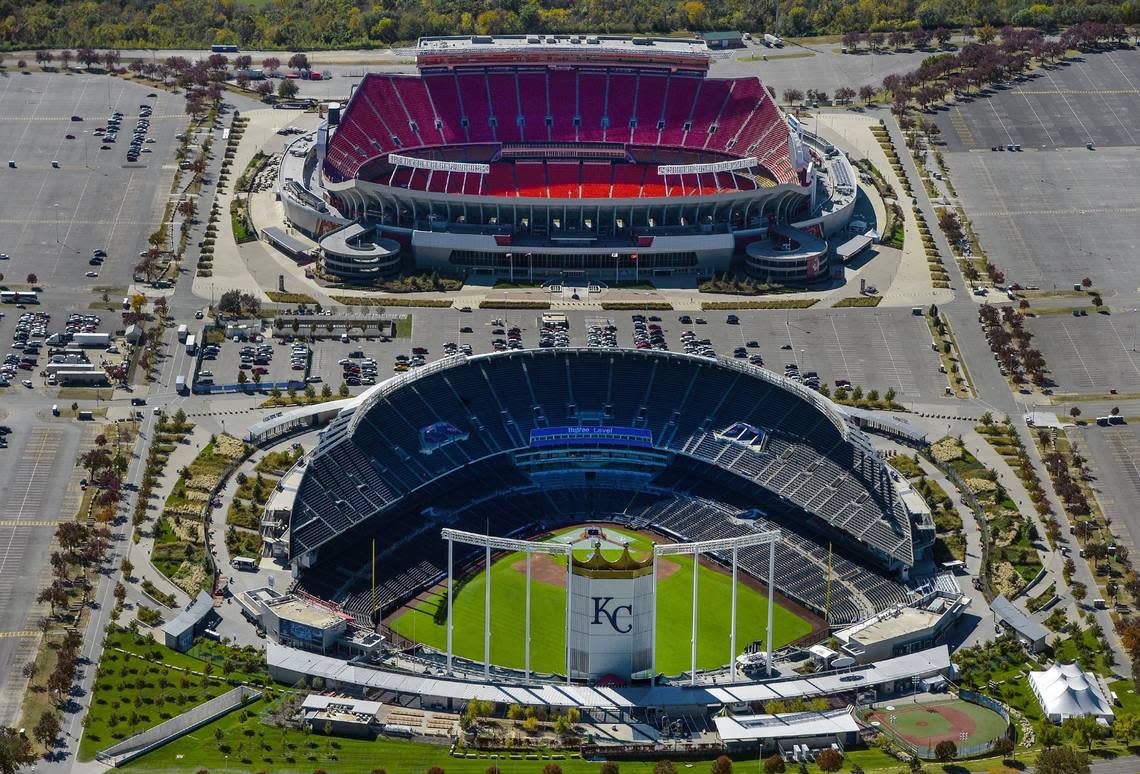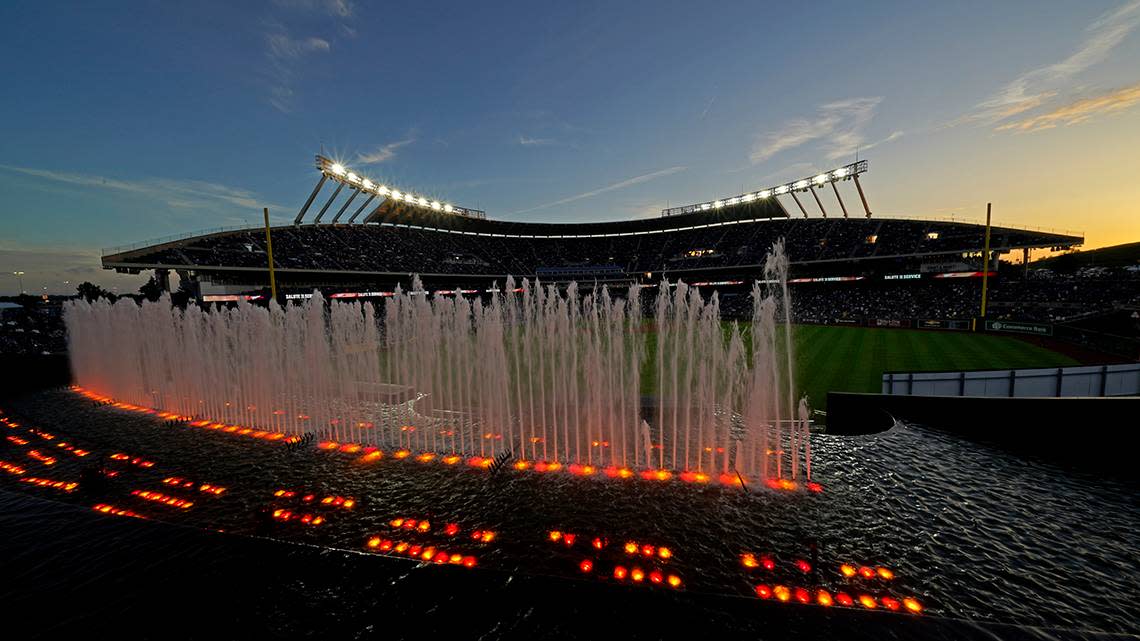Is Kauffman Stadium in as poor shape as Royals say? Depends on how you measure it
Kauffman Stadium turns 50 this year. But the Kansas City Royals aren’t thinking about the past as they make plans for a flashy new home downtown.
There are plenty of reasons why the organization wants to abandon what has often been cited as one of the best ballparks in Major League Baseball before the team’s lease runs out on Jan. 31, 2031. One of them: A new stadium would likely produce more revenue for the team, providing more ways for fans to spend money at the ballpark.
But the Royals and their consultants also say The K would need too much work to serve as the team’s long-time home. They say it would cost as much or more to make the repairs the stadium will need in the future to remain viable.
“It’s becoming challenging to maintain the K,” team owner John Sherman said in a letter to the community last fall explaining why he would like the team to play future games at a new downtown address. “A new home would be a far better investment, both for the local taxpayer dollars already supporting our facility and the Kansas City community.”
To reinforce that argument, the team’s consultants have emphasized the need to fix or replace whole sections of The K if the team were to stay put for decades to come.
A number of cracks have developed and over time up to 70 percent of the stadium would have to be rebuilt, the team says.
Royals add two stops to listening tour regarding downtown ballpark, stadium district
According to experts at the Kansas City-based sports architecture firm Populous, the structure suffers from something called alkali silica reaction, or ASR. Moisture absorbed by the concrete causes the material to swell, crack and crumble, which is called spalling.
“This is typically known as cancer of the concrete,” Sarah Dempster, a principal at Populous, said at a public meeting last month.
“Getting another 30 years of life out of the concrete could require major removal and replacement of the concrete that is affected by the ASR.”
The diagnosis might be surprising for anyone who has read the annual inspection reports that are posted on the website of the Jackson County Sports Complex Authority.
According to those reports, Kauffman and Arrowhead stadiums are both in “satisfactory condition.” There’s no mention of concrete cancer.
When The Star asked a team spokesman about the discrepancy, the Royals issued a statement that said those annual assessment reports and the one Populous produced for the team are not comparable.
“The shortest and simplest answer is that these are two very different reports aimed at very different objectives. One is an annual repair plan and the other is about long-term viability,” the Royals said. “The study referenced in the public meeting came from a leading structural engineer of sports facilities. This firm knows our building well after working on the 2008 renovation. We asked them to evaluate long-term structural issues and the feasibility of extending the existing structure for 40 more years.”
The annual reports
Since 2014, the sports complex authority has hired local engineering firm Burns and McDonnell to report on the condition of the twin stadiums.
With the exception of two years during the pandemic, Burns and McDonnell has issued those report cards. In all but one of the seven reports filed so far, the firm rated Kauffman and Arrowhead stadiums in “satisfactory” condition. The only time that wasn’t the case was in that first report, when both stadiums were said to be in “exceptional” shape.
The inspections are done to ensure that the teams are honoring the terms of their leases, which make them responsible for keeping the properties in good shape. The Royals agreed when the current lease was signed in 2006 to keep Kauffman in “first class condition consistent with other Major League Ballparks.”

Both teams get millions of dollars in cash allowances from state and local taxpayers each year to help fund those repairs and improvements.
Burns and McDonnell began the inspections four years after the completion of $625 million in upgrades. A taxpayer-approved bond issue accounts for three fourths of the total. Only in 2020 and 2021 were the assessment reports skipped.
Both stadiums have experienced some wear and tear, but the teams have made repairs when necessary, the reports say. According to the most recent inspection report published last March, the Royals have performed “the ordinary cleaning and maintenance obligations consistent with a First-Class MLB Baseball Stadium.” The report goes on to list “minor physical deficiencies” in and around Kauffman and suggested repairs.
According to the report: “Such deficiencies are expected in such a large facility and typical of a high-use facility. Most deficiencies can be easily addressed by the Kansas City Royals through standard maintenance procedures.”
Burns and McDonnell cited no major concerns for either Kauffman or Arrowhead.
The reports do note instances of cracked concrete and exposed rebar at Kauffman, but there is no mention of ASR or concrete cancer, nor do they make predictions of what might need to be done years from now to maintain the stadiums.
“While some cracking and spalling was observed,” the 2022 report said, “the original reinforced concrete columns and walls are in satisfactory condition.”
It goes on to note multiple cases where the steel reinforcing rods were exposed, but that “the vertical column and wall surfaces are flat and smooth. Concrete patchwork of the original structure was observed to be flat and smooth and is in satisfactory condition as well. The expansion joints at the original superstructure to the renovation superstructure are in satisfactory condition.”
Sports complex authority executive director Jim Rowland said he did not have the expertise to comment on the condition of the concrete at Kauffman Stadium, who resigned from the Kansas City Council to accept his current job in 2006 and help guide the process that resulted in the current stadium leases. “I mean, obviously, when you get the 50 plus year old concrete, you’ve got, you know, some level of degradation with winter and that kind of stuff.”
But damaged concrete can be repaired or replaced, and ultimately it becomes a choice of whether to make the repairs or build new.
“It’s a value judgment,” Rowland said
‘Concrete cancer’
The team says the Burns and McDonnell reports don’t address Kauffman’s long-term viability.
“It could be helpful here to remember the 2008 renovations were solely focused on fan-facing improvements, leaving the basic structure, systems and infrastructure alone,” the Royals told The Star.
“Those renovations have met fan needs, but now a vast part of our stadium (including almost all of the seating bowl) is original to 1973. The areas referenced with ASR are widespread and over the next 10 years would need to be repaired and/or replaced to be safe.”
Dempster and her boss, Populous global chair Earl Santee, bolstered their client’s argument last month at the first stop of the Royals’ public “listening tour” at the former Westport Middle School.
Their bottom line: It would cost more to upgrade Kauffman to last another 50 years than it would to build its replacement downtown.

In addition to the problems with concrete, she said the fountain area also was of concern. Water leaks have deteriorated some steel and concrete in that space.
“Similarly, at the right field tunnel, there are rust issues that will need to be remediated,” she said.
She also said the HVAC and electrical systems will need upgrades or replacement by the end of the decade. And repairs or replacement of the canopy over the upper deck seating area “would be expected down the road.”
Santee said the lower bowl of Kauffman will need to be replaced “for us to functionally make the building work, and to sustain the ballpark in a way that the Royals can enjoy for the next 50 years.”
He went on to say that 70% of the building would have to be replaced to “meet the current needs of the Royals as they look forward to the next 50 years.”
Populous has designed sports venues across the globe, including serving as the sports architect for Lusail Stadium in Qatar where Argentina beat France in the 2022 World Cup final.
The firm oversaw the 2007-2009 renovation at Kauffman and can trace its lineage to Kivett & Myers, the Kansas City firm that pioneered modern sports stadium architecture with the innovative twin stadium design of the Truman Sports Complex.
Populous was hired by the Royals to evaluate whether it made sense for the team to stay at Kauffman or build new downtown. The team envisions building, with taxpayer support, a $1 billion stadium that would hold 38,000 fans. That vision also includes $1 billion in privately funded development around the stadium that would include housing, hotels, offices, retail and restaurants.
Team officials haven’t announced where downtown they’d like to see that new stadium built or how much taxpayers will be asked to subsidize the project.
“The bulk will be private,” Sherman said at the Westport meeting. “We would expect that private capital would take care of a major part of the ballpark and that private capital would develop all of the ballpark district around the ballpark.”
Sixth oldest ballpark
Five MLB stadiums are older than Kauffman. Opened in 1912, Boston’s Fenway Park is the oldest. Wrigley Field in Chicago opened in 1914, followed by Dodger Stadium in Los Angeles in 1962, and Angel Stadium in Anaheim, California and RingCentral Coliseum in Oakland, California, which both opened in 1966.
Dodger Stadium underwent a $100 million upgrade two years ago and played host to MLB’s All-Star Game this past July. Revered by baseball fans everywhere for its size, dimensions and history, Dodger Stadium was, like The K, built specifically for playing baseball at a time when round, all-purpose, cookie-cutter stadiums had become the norm.
“It’s kind of like baseball’s cathedral,” longtime Dodgers third baseman Justin Turner told a columnist for the Los Angeles Times last summer.
On multiple lists of the best ballparks to watch a game, Kauffman also regularly ranks in the top tier. The Washington staff of NBCSports.com ranked The K ninth best out of the 30 Major League Baseball parks in 2020, calling it “perhaps the most under-appreciated ballpark in the majors...that has stood the test of time quite well.”
The Royals are likely to hear a lot of love for Kauffman as they try to sell their vision for a new stadium to Kansas Citians. At least two more listening sessions are planned.
The club will host the public at 5 p.m. Tuesday at the Urban Youth Academy, 1622 E 17th Terrace, in Kansas City. Another session is planned for 5:30 p.m. Wednesday at The Midwest Genealogy Center Community Hall at 3440 S. Lee’s Summit Road in Independence.
